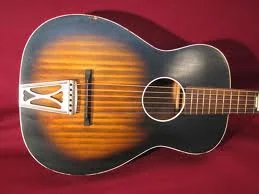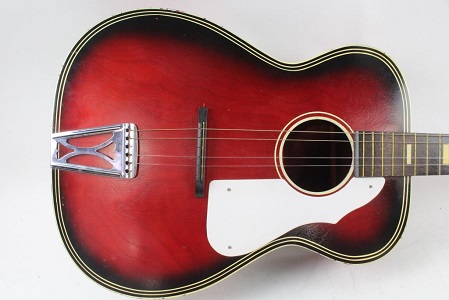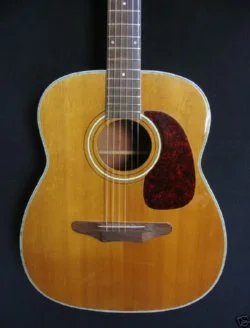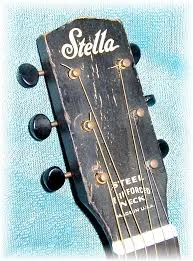Harmony was among the most popular guitar makers in the USA, producing most all of their guitars in Chicago during the peak years in the mid 1960s.
They made many types of stringed instruments, including ukuleles, acoustic and electric guitars, and violins. Founded in 1892 by Wilhelm Schultz a German immigrant from Hamburg. In their day, they made more guitars than all the other guitar makers combined. They altered designs, for each design of guitar popular throughout their history.
Wilhelm J.F. Schultz, a mechanic, came to Chicago and got work at the Knapp Drum Company. Knapp was bought out by a large instrument production giant, Lyon & Healy, and Schultz became supervisor of the drum operation.
In 1892, Schultz left Lyon & Healy and, with four workers, started Harmony in a loft of the Edison Building situated at Washington and Market Streets in Chicago, later on the website of the Civic Opera House. It is not completely certain that the initial company was called Harmony in its early history as it did not begin to actually use the Harmony name until the 1920s.
Very little info is known about the earliest Harmony-made guitars. Probably few made it through, however likely they were little acoustics that used with gut strings, and glued-on bridges. Likely they would also have had three dots at the fifth, seventh, and 10th frets.
Essentially, markers at the 10th fret, versus the ninth (found on a few guitars and banjos before the 1880s), was a technique utilized by guitar makers who intended to sell their instruments into the tremendously popular mandolin orchestras at the time.
Mandolins had position markers at the 10th fret. The guitar of the 1890s was either utilized mostly for singing accompaniment or as a continuo instrument in mandolin and banjo orchestras of the time. Harmony and its early main competitor, Oscar Schmidt, of New Jersey, continued to prefer use of the 10th fret long after many other major makers picked the ninth fret (some, like the Larson Brothers, likewise continued to use 10th-fret markers).
By 1894 there were some 40 employees working at Harmony as Chicago was a hotbed of commercial manufacturing offering opportunity to European immigrants pouring into the country. Chicago was at the transport crossroads of the nation as transcontinental railroad lines and resting on the Great Lakes, and simply over 100 or two miles from the mighty Mississippi River.
Due to location, Chicago ended up being the provider of products for the Heartland of America. Chicago was the home of the mail-order product business, which played a significant function in the dissemination of the guitars throughout America and the increase of the guitar makers there.
Montgomery Ward promised to offer only American-made guitars in their 1894 catalog, which they declared were of superior manufacture, made "scientifically," and ensured not to warp or split ... as long as you didn't use steel strings! They abandoned the sale of imported guitars due to the fact that they might not withstand the weather changes they went through in the New World. Likely, these guitars were from German makers.
Ward's was selling Lyon & Healy-made Washburn guitars and probably some low-end Bohmann guitars that included birch wood with fake wood grains.
When Sears, Roebuck and Company entered into the picture, they were offering the exact very same guitars in their brochure. Given that Sears was officially a watch and precious jewelry company these were the first guitars they marketed for sale.
By 1897, Sears was working with the new Harmony company offering new guitar designs. These were mostly little bodied parlor guitars which were popular at the time.
Seen in the '97 Sears brochure was early Harmony made guitars like the No. 7102 "Euterpe," a standard-sized guitar with an orange top (wood unspecified) and a body of quartersawn oak. The top was bound with a light/dark block marquetry purfling, as was the sound-hole.
The neck product was also unspecified, however typically these had cedro or "Spanish cedar" necks, a wood like mahogany. The Euterpe had an 18-fret ebonized fingerboard, and our telltale three dots at five, seven and 10. The pin bridge had little elevated squares on the wings, normal of some Harmony bridges. This cost? $5.75, with money-back warranty!
The No. 7106 "Troubadour," at $8.65, was another requirement with an orange top, this time made from strong mahogany. Unlike the Euterpe, this had a "convex" or ovaled ebonized fingerboard (5/7/10 dots), and a colored ring rosette. The top was unbound.
The bridge was the same as on the Euterpe. For $.30 more you might get the No. 7107 Troubadour, which included white celluloid binding to the top. The Euterpe and Troubadours were provided until 1899.
In 1899, Sears broadened the line of guitars, from Harmony and by Oscar Schmidt of Jersey City, New Jersey. Harmony guitars on the lower end, Schmidt guitars had the upper end. This arrangement was offered for decades.
Chicago's Montgomery Ward & Co. had begun its catalog sales to Grange farmers in 1872, and by 1890, just 2 years prior to Harmony's arrival, had become the world's largest retailer.
Sears, Roebuck & Co., which had begun as a watch company in Minnesota in 1885, became a full merchandise mail-order catalog service in late 1893, offering its very first catalog in 1894 and relocating to Chicago in 1895. By 1900, Sears had actually surpassed Ward's to become the world's biggest shop.
In 1914, Sears adjusted the name Supertone for its musical instruments (likewise utilizing this name for record players and records they sold). The instrument offerings and suppliers remained the exact same, this was Sears' very first huge brand. Practically simultaneous, Sears' crosstown competing Montgomery Ward presented its Concertone brand name. And this was utilized on a nearly similar series of guitars!
By 1915 Harmony was the first large scale ukulele contractor. Sears, Roebuck and Co. bought Harmony in 1916 to corner the ukulele market. At the time Harmony was led by Joe Kraus, who was chairman till 1940.
In 1928, Harmony presented the first of many Roy Smeck designs, and went on to become the biggest producer in the U.S. They offered 250,000 pieces in 1923 and 500,000 in 1930, including numerous designs of guitars, banjos, and mandolins.
In the late 1930s, Harmony started making violins again after a 19 year hiatus. They likewise bought trademark name from the insolvent Oscar Schmidt Co.-- La Scala, Stella, and Sovereign.
These instruments were still mainly offered through huge mail order catalogs like Sears Roebuck (Silvertone) or Montgomery Ward (Airline) making them easily available to everybody. These were the days way prior to the Internet, eBay and Reverb.
Plus prior to Asian imports were available. Lots of towns in America did not have a music store nearby. Harmony provided a number of the big mail order catalogs through the years which were the same Harmony-made instruments except for the label in many all cases.
It is not uncommon to see the same vintage Harmony guitar model with different branding. Some Harmony instruments, although were considered by lots of players the "poor man's" Gretsch or Gibson. However they have their own special tone and vintage vibe.
Numerous designs have actually become sought after and popular in the classic market like the mid to late '60s Harmony H22 Bass, Harmony Rocket, Harmony H78 (Dan Auerbach of the Black Keys), 1967/68 Sovereign acoustic, Silvetone 1446 (Chris Isaak), Harmony H72 Meteor and Harmony Strattone H44 for examples.
Interestedly, H1260 Sovereign was Jimmy Page's main acoustic during the early years of Zeppelin. Any high-grade Harmony made guitar are preferable in today's classic market, but typically priced way lower than Gibson, Fender or Martin making them a deal, depending upon condition and playability.
Harmony was, especially in the early days, capable of turning out guitars with pretty good workmanship. But these guitars were never ever positioned to compete with D'Angelicos, much less Gibson, Gretsch or Fender. Harmony built guitars were many times a players first instrument.
Harmony made guitars were played by Howlin Wolf, Big Joe Williams, Elmore James, Elvis, Ritchie Valens, The Stones, Small Faces and others. However, there are more than sentimental needs to have an interest in Harmony guitars.
Instruments were sold under a variety of trade names-- Vogue, Valencia, Johnny Marvin, Monterey, Stella, and others. In 1940, after Kraus had a conflict with management, he left, but then purchased sufficient stock to reboot the company independently.
Harmony peaked in 1964-1965, selling 350,000 instruments, but low-end foreign competitors caused the company's demise 10 years later on. Between 1945 and 1975, the Chicago company mass-produced about ten million guitars.
The business lowered their output for many years, later on focusing on student designs sold through JCPenney. Note that a few of the guitars sold in the Sears and Wards catalog where also manufactured by Valco and Kay business.
In the 1930s, Valco was formed by 3 service partners and former owners of the National Dobro Company; Victor Smith, Al Frost, and Louis Dopyera. The business name was a combination of the 3 partner's first initials (V.A.L.) plus the common abbreviation for business (Co.).
Valco made Spanish acoustic guitars, metal-bodied resonator guitars, electric lap steel guitars, and vacuum tube amplifiers under a range of brand names consisting of Supro, Airline, Oahu, and National. They likewise made amplifiers under contract for several other companies such as Gretsch, Harmony, and Kay. In the 1960s they began producing solid body electrical guitars.
Kay Musical Instrument Company, USA musical instrument producer also started its operations in the 1930s in Chicago, Illinois by Henry Kay Kuhrmeyer, from the properties of the previous Stromberg-Voisinet, which was founded as Groeschel Mandolin Company in 1890.
Kay offered their first electrical guitar in 1936-- 5 years after the Rickenbacker Frying pan, and the very same year as the Gibson ES-150. Valco merged with Kay Musical Instrument Company in 1967, however the merged business quickly failed in 1968 because of financial troubles.
Harmony guitars, although they were primarily marketed to beginners, also developed some guitars to attract professional players. The H78 was one of Harmony's much better quality guitars. Note that all Harmony guitars these were mass produced. Low-cost rock-and-roll makers. Harmony produced a lot of various models under different trademark name.
Harmony's higher-end archtops can be rather resonant, as a lot of all of the early guitars-- at least those made in America, instead of subsequent imports-- were made of solid woods like solid spruce or mahogany and not plywood.
The lower end designs were normally made of birch and have the binding painted on. Instead of inlaid fret markers, the markers were merely painted in the suitable places. The tailpieces on a few of the lower end models were made of pushed metal. Some have the tailpieces or pick guards screwed into the wood.
The necks on a number of the Harmony guitars did not have adjustable truss rods. Instead the graphics on the head stock reveal, "Steel Reinforced Neck." Numerous Harmony guitars have actually kept a straight neck.
Old DeArmond single-coil pickups gracing the solids and Rocket thin lines which can sound excellent into a cranked up amp. The pickups on almost all Harmony electrical guitars and basses were produced by Rowe Industries Inc./ H. N. Rowe & Company/Rowe DeArmond Inc./ DeArmond In. in Toledo, Ohio.
A number of the instrument amplifiers badged with the Harmony name were manufactured by Sound Projects Company of Cicero, Illinois.
The Harmony solid body electrics in the late 1950s and early 1960s were generally aimed at the novice market with names such as Stratotone and BobKat models. The much better instruments were the thin line hollow body electrical guitars such as the Harmony Rocket or H78.
Some designs even had up to three DeArmond pickups each with specific volume and tone controls. Harmony guitars generally did not have the quality of Gretsch and Gibson. For the cash these were quite nice instrument and have their own unique noise due to the way they were build and the pickups they utilized. Have to love the tone of a gold-foil pickup.
Interesting truth is that when Fender was trying to burglarize the acoustic guitar market, the very first guitar line they used in their catalog was actually made by Harmony with the Fender brand name on the head stock. Baldwin after purchasing Burns and Gretsch brands, did not have a classical design, so they had Harmony produce "Baldwin" classical guitars.
The late 1960s and early 1970s were bad times for U.S. guitar makers with Vietnam War and inexpensive Asian imports rushing in to the market. None of the American guitar makers were succeeding in this period and it quickly spelled completion for USA Harmony guitars.
In 1975, the Harmony Guitar Co. in Chicago ceased operations and had a three day auction. The auction was substantial considering that it was 2 city blocks under one roofing system. Should have been some event! Later on in the 70's the Harmony name was offered to be used on Asian guitars.
Keeping with their custom of selling through brochures and outlet store, the 1990's saw Harmony offer the majority of their guitars to J. C. Penny shops. The Harmony hallmark and all intellectual property was acquired in 2009 by Westheimer corporation in Northbrook, IL. In 2011 they debuted the New Harmony Vintage Reissue series.
Author: Jim Bruce
Date: 2015-05-12
Category: Music
 Stella was a brand of guitars owned and
operated by the Oscar Schmidt Company and was founded around 1899. The
company produced low to mid level stringed instruments.
Stella was a brand of guitars owned and
operated by the Oscar Schmidt Company and was founded around 1899. The
company produced low to mid level stringed instruments. 

Most of the guitars I see appear to be from the sixties. Mainly because of the guitar boom during the Beatles generation, there were a large number of guitars sold at this time.

